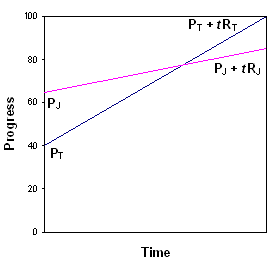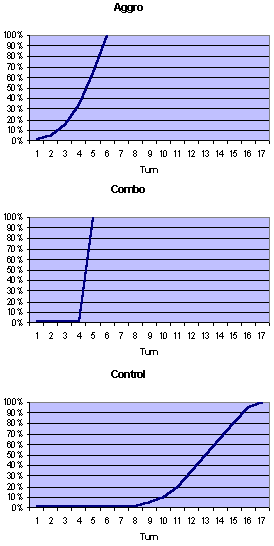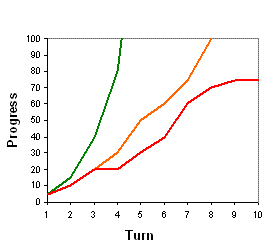
Last time on "Magic Theory From The Ground Up," we made the first foray into tempo. In this issue, we'll be looking at the tempo-related concepts of progress and development. It's been a long time since that third installment, so without further ado... let's get started!
(Sidenote: For those new to this series, you can find the previous articles here: #1 #2 #3)
Progress
Some time ago, I stumbled across a theory article by a player named Michael Devine. In it, he described what he called a "new way of looking at Magic": progress theory. Oddly enough, I had at the time been working on a similar concept, and his article helped me formulate my own understanding of the topic.
You see, the term "tempo" has long been a vague word that people throw around to refer to a variety of things. One very related concept is this idea of progress, and it is very often just lumped together with tempo. However, players like Michael and I prefer to separate the two ideas, as it makes it easier to discuss them more completely.
While my own theory of progress differs from Michael's, we do at least share a definition of progress: progress is a measure of a player's advancement toward winning the game. Each player starts at 0%, and reaching 100% means that the player has won. Both players are racing for progress, while simultaneously trying to slow down the other player. In most cases, progress can easily be measured in terms of life. Each point of life you take away from your opponent increases your progress, and when you finally deal the 20th point of damage, you reach 100%.
Although Michael and I share this definition, we each measure progress differently. He counts resources as part of progress, while I do not. To me, only playing lands does not get you any closer to winning; it all depends on what you do with those resources. So under my theory, the only things that can potentially increase your progress are threats, and you only increase your progress when those threats actually do something. Timmy doesn't get any closer to winning if he never makes his Darksteel Colossus attack, right?
This is why having a lineup advantage is important. Your threats are much more likely to advance your progress when you have the advantage. After all, a Trained Orgg can do much more against an opponent with nothing than it can against an opponent with two Sundering Titans. So whenever you have the lineup advantage, you have an opportunity to make progress.

So how are tempo and progress related? Progress simply tells you how close you are to winning, while tempo tells you how fast you're doing it. I previously defined tempo as your rate of development, which can apply to all types of resources, but you can also think of your overall tempo as your rate of progress.
Aggro vs. Combo vs. Control

You can also imagine three runners who have to complete a certain number of laps on a racetrack. The "aggro" runner is simply focused on running as fast as possible to finish quickly before the other runners do. The "control" runner is not as fast, but he figures he can still win if he instead focuses on sabotaging the other runners and laying traps in their lanes to slow them down enough. Meanwhile, the "combo" runner decides to hastily build a rocket-propelled vehicle that will instantly zoom around the track in the blink of an eye.
Note that each strategy's rate of progress is meaningless unless it's compared to that of another strategy. Each one will eventually cross the finish line, but the important question is whether it will finish before either of the others. You can also see that there's quite a difference between focusing on your own rate of progress and focusing on your opponent's rate of progress. In order to speed up your own rate of progress, you'll want to consider resource tempo and resource acceleration. On the other hand, in order to hinder your opponent's rate of progress, you'll instead want to consider resource disruption. The less able your opponent is to use his resources, the less progress he can make.
There's actually another way you can affect an opponent's progress - finding a way to set the finish line farther back. Unfortunately, this is only a temporary measure, and a fast opponent might still reach that farther finish line before you reach yours. This is why relying on lifegain is generally a bad idea, since it doesn't actually affect your opponent's rate of progress. This method will only make a difference if you can move that finish line a very long distance back (such as with "infinite life" decks), or if your decks are about equal in terms of speed and that extra distance is just enough to win you the game (or buy you enough time to take control of the game).
Stages of the Game, and Critical Turns
It should be clear that whether a deck is "fast enough" is completely dependent on the competition it's up against. So Magic players need some way of analyzing and comparing decks in terms of speed and power. Borrowing a concept from other strategic games, the Magic community has adopted the practice of discussing a deck's strength during different stages of a match: the "early game," the "middle game," and the "late game." But what exactly do these terms mean when progress is so relative?
Traditionally, the three terms (early, middle, and late game) have been applicable to any game involving strategic development over time. Although differentiating between these stages is always arbitrary, it's much simpler when applied to games where both players have similar options and resources available to them (such as chess). In general, the "early game" refers to a period of development and preparation. The "middle game" is where most of the significant interaction between players takes place, and the "late game" (or "endgame") is simply a matter of tying up loose ends and finishing the job.
Games like Magic aren't so simple, though. On turn three, some decks may still be in the preparation stage, while others may have already dealt the finishing blow. Fast aggro decks may seem to skip the early game entirely and head straight for the middle game. In effect, the stages of the game have become merely loose terms used to describe how many turns have passed, rather than accurately reflecting what the decks are really doing.
Rather than relying on these terms, it will be much more useful to think about a deck's critical turns. These can be just as hard to define, but they can provide a much better sense of how a deck progresses. Since any deck should have some ideal plan for winning, we can designate certain parts of that plan as being very important for advancing the deck's progress. The turns on which the deck expects to execute those parts of its plan are then marked as the critical turns, and these have two properties - timing and purpose.
As an example, consider a fast aggro deck like Sligh. Ideally, it wants to drop creatures at the top of its mana curve every turn early on. Theoretically, one could consider turns 1-4 as all being critical turns, as each of those turns is vitally important to the Sligh deck winning. Such a strategy times its critical turns to be early in the game, all with the purpose of playing threats. On the other hand, consider a generic UW control deck. Turn one is generally insignificant, but turn two is critical because at two mana, the control deck now has access to one of its key defenses: countermagic. Similarly, turn four may also be a critical turn due to being able to cast Wrath of God. Such a deck times its critical turns to come later than the aggro deck, and the purpose is playing important answers rather than playing threats.
Because of deck limitations and the nature of progress in Magic, each deck has a limited number of critical turns. The three fundamental decktypes make use of these turns differently, both in timing and in purpose.
- A pure aggro strategy will generally have several critical turns very early in the game, and almost none later on (except in the case of a contingency plan).
- A pure combo strategy will similarly have several critical turns early on (assembling the combo pieces) and one final critical turn when the combo is put together.
- A pure control strategy will typically have a couple critical turns early on to slow down the other strategies, aiming to reach a later critical turn where it strongly stabilizes, followed by a critical turn some time later when it plays its win condition.
The concept of critical turns has long been around, starting in the form of Zvi Mowshowitz's "fundamental turn" (FT). His first use of the concept expressed each deck's FT as a single number - the turn in which the deck effectively wins the game. But even though the FT is the most critical turn, we can still gain a lot from examining a deck's other critical turns. As we'll see when the theory is developed more later on, critical turns are strongly related to the interaction between mana curves and cost distributions, as well as the determination of a deck's weaknesses to disruption.
Critical Turns in Matchups
Instead of just looking at critical turns in a vacuum, let's consider two decks facing off against each other. First of all, the "faster" deck is the one that expects to reach 100% progress earlier, ignoring the other deck. In an aggro vs. control matchup, the aggro deck is clearly the faster deck, since the control deck's threats don't come into play until much later on.
Whoever has the faster deck should be playing on the offensive, forcing the slower deck to react and try to keep up. Because a control deck can never count on outracing an aggro deck, the control deck must instead focus on disrupting the aggro deck's progress. Every time the disruption is successful, the aggro deck's critical turns become negated or delayed, hopefully to the point where the control deck becomes the leader in the progress race. On the other hand, if the control deck allows the aggro deck to achieve too many critical turns early on, the aggro deck will be way ahead in the progress race, and the control deck can never hope to run the full 100 meters before the aggro deck finds a spurt to finish the last 10.

Even in matchups of similar types (e.g. aggro vs. aggro), the critical turn sequences are still just as important. One of the most influential articles in Magic history (Mike Flores' Who's the Beatdown?) covers this point very well. Essentially, the faster deck gets to play the beatdown role, while the slower deck is forced to play the control role and find some way to hinder the faster deck in order to compete. If the slower deck misassigns its role and tries to play beatdown, it will simply get outraced. Of course, determining the beatdown role involves more than just speed; it also involves evaluating which deck has more power, has more removal/permission, and is better geared for the long run. This topic deserves more attention than this article can allow, however, so expect us to come back to it later on in the series.
One Small Step for Progress
This is really just a very small step in our quest for fully understanding progress, development, and tempo. Our next step is to continue building upon the theories of progress and tempo to make them much more useful. It's also about time that our (perhaps forgotten?) "heroes" Timmy and Jimmy start playing some real Magic, using randomly shuffled 60-card decks! What lies in store for our young planeswalkers? Stay tuned for the next episode to find out!
-fadeblue
Credits: Dr. Tom (editing), iloveatogs (banner)
Comments